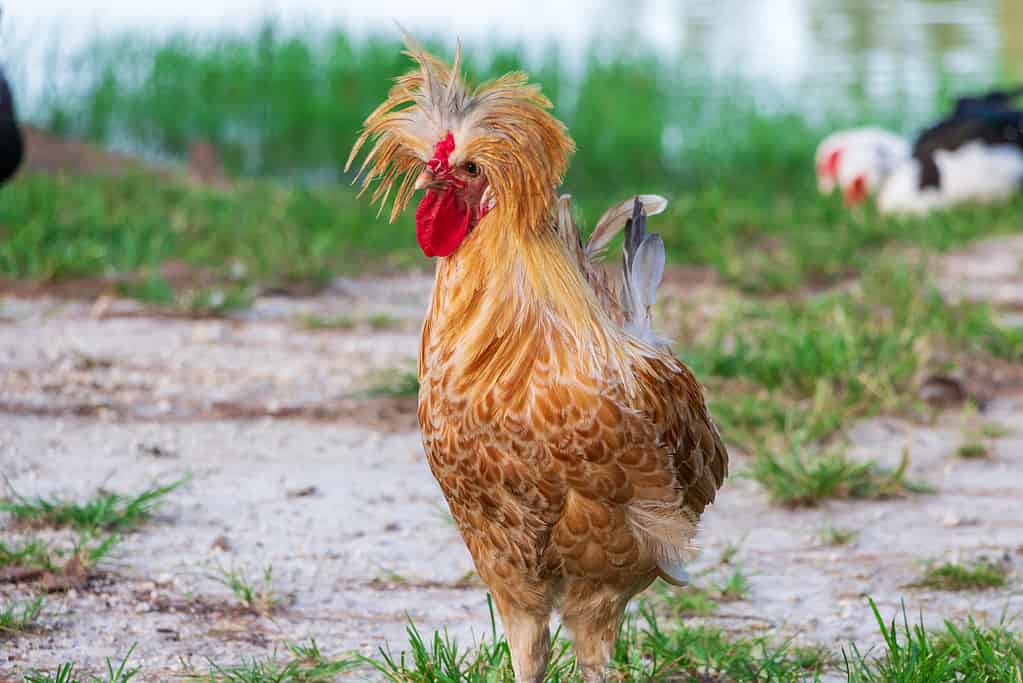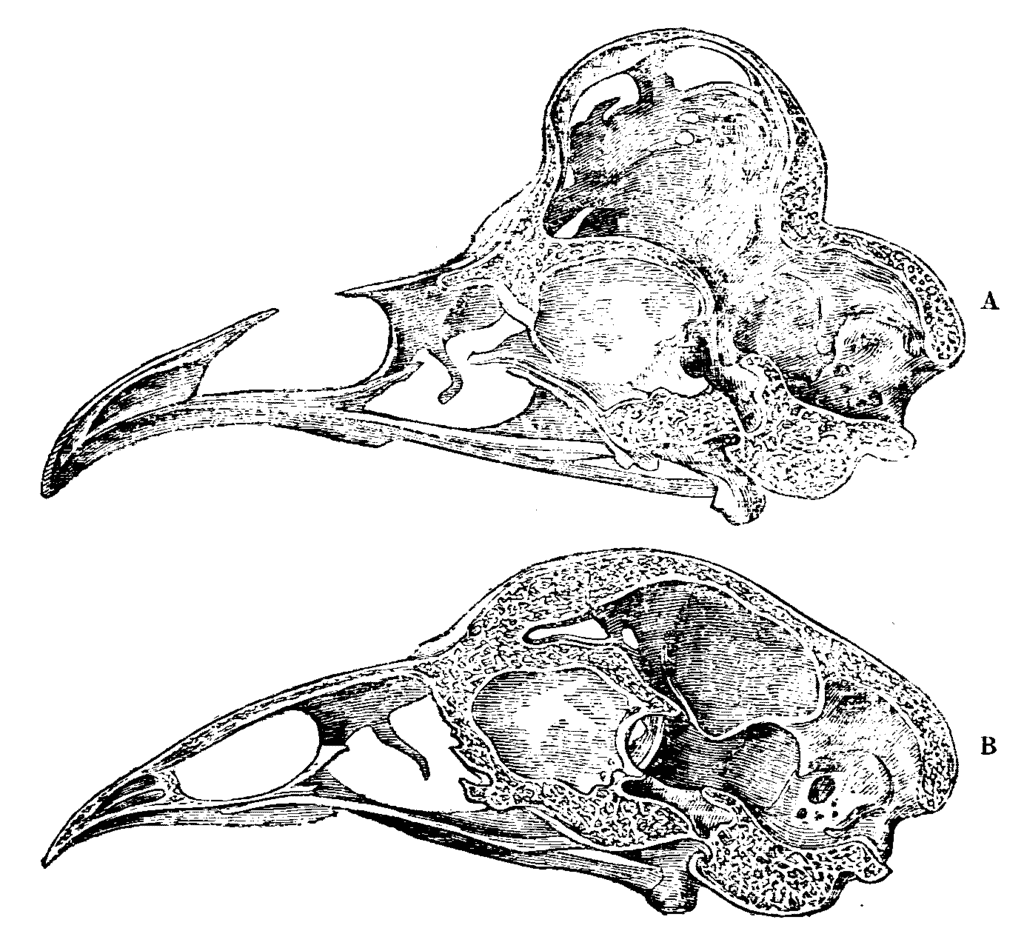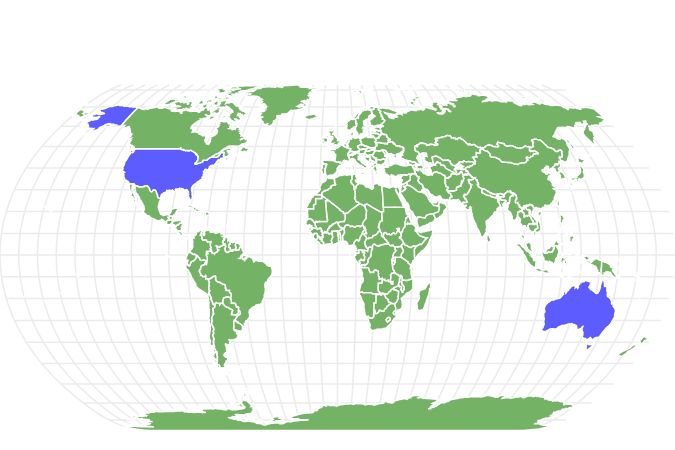Polish Chicken
Gallus gallus domesticus
The Polish chicken has a large, feathered crest supported by a round, bony prominence on the skull!
Advertisement
Polish Chicken Facts
- Prey
- Insects, larvae, worms, other invertebrates, lizards, frogs, mice
- Main Prey
- Insects
- Name Of Young
- Chicks
- Group Behavior
- Flock
- Fun Fact
- The Polish chicken has a large, feathered crest supported by a round, bony prominence on the skull!
- Estimated Population Size
- Fewer than 10,000 worldwide
- Biggest Threat
- Lack of continued interest in breeding
- Most Distinctive Feature
- Large, round, feathered crest that resembles a pom pom
- Distinctive Feature
- Small, slender body; full tail held semi-upright; small, red, V-shaped comb; red wattles; white earlobes; beak with large nostrils; gray feet and legs; some birds have frizzled feathers; some birds have beards and muffs, large ball-shaped protuberance on top of skull
- Other Name(s)
- Poland chicken; Paduan chicken; Top Hat chicken
- Temperament
- Friendly and gentle
- Incubation Period
- 21 days
- Habitat
- Captivity
- Predators
- Birds of prey, foxes, raccoons, weasels, snakes, etc.
- Diet
- Omnivore
- Lifestyle
- Flock
- Favorite Food
- Commercial feed
- Origin
- Modern version originated in the Netherlands
- Number Of Species
- 1
- Location
- Europe, the United States, Australia
- Group
- Flock
- Nesting Location
- In coops
Polish Chicken Physical Characteristics
- Color
- Red
- Blue
- Black
- White
- Gold
- Silver
- Multi-colored
- Golden
- Skin Type
- Feathers
- Lifespan
- 6 to 8 years
- Weight
- 4.5 to 6 pounds
- Height
- 12 to 15 inches
- Age of Sexual Maturity
- 20 to 24 months
- Venomous
- No
- Aggression
- Low
View all of the Polish Chicken images!
The Polish chicken has a large, feathered crest supported by a round, bony prominence on the skull!
Polish chickens are funny looking birds. With their big, round crests the shape of feathered pom poms and their interesting color combinations, they look a little bit like Muppets. These birds have been around for hundreds of years, dating back to perhaps the Middle Ages and beyond. They have a bony structure the shape of a hollow ping pong ball that supports their feathery crest. It also houses the front half of their dumbbell-shaped brain. The modern version of Polish chickens originated in the Netherlands, where Dutch breeders worked to perfect the round crests we know today. These friendly birds make excellent backyard companions, as long as you don’t sneak up on them from behind.
Incredible Polish Chicken Facts
- Unlike many other fowl, Polish chickens are not named for their place of origin.
- Polish chickens tolerate both heat and cold fairly well, but they hate being wet.
- The facial features of these birds are often obscured by their large crests.
- Some varieties of Polish chickens have beards and muffs in addition to their crests.
- Although Polish chickens lay up to 200 eggs per year, they are mostly raised as show birds.
- Birds of prey pose a serious threat to Polish chickens because they can’t see them swooping down.
Where to Find Polish Chickens
Polish chickens live mostly in Europe, the United States and Australia. These European birds have a disputed origin. Some sources say that the ancestors of the beautifully crested Polish chickens were brought to the Netherlands from Spain. Other sources say they originated in Asia and were brought to Europe by Mongols as early as the Middle Ages. Artistic representations of chickens resembling the crested Polish in Europe date back as far as six centuries.
Experts agree that the modern version of these birds came from the Netherlands. Dutch breeders worked to improve the crests of Polish chickens and create the breed we recognize today. By the 18th century, Polish chickens had spread across Europe, becoming quite popular in both England and France.
Exporters sent the breed to the United States around the time of the Civil War, where it rose in popularity through the 1850s. The American Poultry Association added three varieties of Polish chickens to their Standard of Perfection in 1874. The association added more varieties later. Unfortunately, however, the breed began to decline as farmers favored other chickens, including the Leghorn, which was a superior egg producer. Polish chickens, though still popular as show birds and pets, now have a declining worldwide population. The population is low enough that the Livestock Conservancy has placed them on their watch list.
People interested in starting or expanding a flock can purchase Polish chicks for as little as $4.00 per chick or more than $15.00. The cost per chick depends on the hatchery and the pattern of the birds.
Scientific Name
Polish chickens share their scientific name with other domesticated chickens all over the world. Gallus gallus domesticus, the name given to the modern domestic chicken, derives from the scientific name of its ancestor the Red Junglefowl, Gallus gallus. This bird was first named in 1758 by Linnaeus.
The common name of Polish chickens might suggest that they originated in Poland, but evidence indicates otherwise. Polish chickens, also known as Poland, Top Hat, or Paduan chickens, might have been named such because the Dutch word, Pol, means big head. They might also have been called Polish chickens because of their resemblance to the crested hats worn by Polish soldiers.
Appearance
Most people recognize Polish chickens by their large, rounded crests. The breed is one of more than a dozen recognized crested chickens, including the Houdan and Sultan chickens. The Polish chicken has probably the roundest and fullest crest of all, though. Some individuals have beards and muffs, causing the feathers to surround the bird’s head like a complete ball of fluff.
This small breed ranges in height from about 12 to 15 inches. They weigh from 4.5 pounds to about 6 pounds. The bantam variety, which breeders developed by crossing the larger birds with smaller chickens, weighs only 26 to 30 ounces at maturity. Their body is slender and their feathers appear soft and sleek, unless they are of the frizzled variety. They have neatly arranged tails with long sickle feathers that they carry semi-upright.
The feathers of Polish chickens often obscure their facial features. Hens have neatly rounded crests with individually rounded feathers, while roosters have wild crests with pointed feathers. They have a small, red, V-shaped comb and red, rounded wattles. They also have white earlobes and their beaks sport large nostrils. Their gray legs and feet have no feathers.

Polish roosters have wild, pointed feathers on their crests like this buff laced Polish chicken.
©Sunshower Shots/iStock via Getty Images
Color Patterns
According to the Poultry Club of Great Britain, Polish chickens were among the chickens shown in the first poultry show in London in 1845. At that time, the show admitted Polish chickens in Gold, Silver Spangled, Black, and White. By 1865 Great Britain standardized the breed and included categories to include the White-Crested Black, Golden, and Silver variations.
The American Poultry Association recognizes ten different color patterns in both large and bantam varieties, and another color, Non-Bearded Black Crested White, in only the large size. The association recognizes the following colors in both sizes: Bearded Buff Laced, Non-Bearded Buff Laced, Bearded Golden, Non-Bearded Golden, Bearded Silver, Non-Bearded Silver, Bearded White, Non-Bearded White, Non-Bearded White Crested Black, and Non-Bearded White Crested Blue.

The skull of a Polish chicken
rooster
(A) compared to that of a Cochin chicken rooster (B) of similar size.
©Charles Darwin, Public domain, via Wikimedia Commons – License
An Unusual Skull
Polish chickens have a large, round, bony protuberance on the top of their skull. This structure, shaped somewhat like a ping pong ball, supports the feathers in the chicken’s crest. The Polish chicken has a dumbbell or peanut shaped brain that herniates into this bony cavity. Although the brain is of similar overall size and weight as compared to other chickens of the same size, the Polish chicken’s brain has more cerebral matter and less in the way of cerebellum and medulla.
Behavior
Owners describe Polish chickens as friendly and gentle birds. They reportedly enjoy the company of humans and often follow their owners around. Listeners say that they have a melodic voice. Even the roosters reportedly crow in a pleasant, non-abrasive way.
These active birds fly very well, and one might just as easily find them hanging out on a tree branch or other high perch as foraging on the ground. Owners might want to provide completely enclosed runs, because even high fences are unlikely to keep a flighty Polish chicken contained.
Polish chickens startle easily, mostly because their large crests obscure their vision. Although sneaking up on an unsuspecting chicken might sound like fun, owners suggest always talking to the skittish birds as you approach, so they don’t fly away.
Diet
Polish chickens primarily eat commercial chicken feed. They need a diet high in protein to support their feathers and overall growth. The hens also need ample calcium to support egg production. This breed is good at foraging, and will happily eat insects, larvae, worms, and other invertebrates. Polish chickens move fast on their feet and can catch lots of prey if given the change to range. Like other fowl, Polish chickens also enjoy eating seeds and green plant parts.
Owners should take great care to provide clean drinking water and a clean place to eat. Because wet feathers around a Polish chicken’s face can cause health problems, alternative watering systems may benefit the birds. A specially designed nipple watering system may work better than a simple bowl or trough for keeping Polish chicken feathers dry, especially in the winter.
Reproduction
Polish chickens lay between 150 and 200 white, medium-sized eggs each year. Hens rarely tend to go broody, and they tend poorly to their eggs, often refusing to sit on them until they hatch. The eggs require about 21 days for incubation. Chicks reach maturity by about 20 weeks of age.
Polish chicks are easy to distinguish from other breeds by the rounded protuberance on their skull. It sticks up prominently long before the chick’s crest of adult feathers begins to fill in.
Predators & Threats
Thanks to their adept flying ability, Polish chickens can easily evade most common ground predators, such as foxes, raccoons, and weasels. However, due to their obscured vision, they face substantial threats from large birds of prey such as owls, hawks, and eagles. Their large crests simply prevent them from seeing a swooping bird of prey. Owners can protect their Polish chickens by providing them with enclosed areas where they can spend time outdoors safely.
These chickens must have secure coops for nighttime roosting. A tightly secured coop helps prevent nest predation by snakes or other predators, and it keeps the birds safe from the weather.
Although Polish chickens tolerate both heat and cold fairly well, they do not deal well with wet weather. Like other crested birds, these chickens may get eye infections and other maladies if their feathers get wet and droop onto their faces.
Coops should also be spacious enough so that Polish chickens do not peck at one another or pull feathers from each other’s heads. Extra space and clean living conditions can also help prevent the spread of lice, which commonly inhabit the crests of these chickens.
Lifespan
Polish chickens have an average lifespan of about six to eight years. Birds that receive proper care, with special attention to keeping them clean and dry, live longer than those that do not. The Livestock Conservancy lists this breed on its Conservation Priority List in the watch category. This category includes breeds of poultry that have fewer than 10,000 individuals worldwide. Continued interest in the breed as a show and exhibition bird is integral to its long-term survival.
View all 192 animals that start with PPolish Chicken FAQs (Frequently Asked Questions)
What do Polish chickens look like?
Polish chickens are a small breed known for the large, round crests on their heads and the wide variety of color patterns. Their body is slender, and their feathers appear soft and sleek, unless they are of the frizzled variety. They have neatly arranged tails with long sickle feathers that they carry semi-upright. The feathery crests of Polish chickens often obscure their facial features. They have a small, red, V-shaped comb and red, rounded wattles. They also have white earlobes and their beaks sport large nostrils. Their gray legs and feet have no feathers.
How big are Polish chickens?
Polish chickens range in height from about 12 to 15 inches. They weigh from 4.5 pounds to about 6 pounds. The bantam variety, which breeders developed by crossing the larger birds with smaller chickens, weighs only 26 to 30 ounces at maturity.
How well do Polish chickens fly?
Polish chickens are excellent flyers. They are lightweight and have strong wings. They are just as comfortable sitting in the branches of a tree as they are on the ground. They may prefer to roost on high perches.
How many varieties of Polish chickens exist?
Polish chickens belong to the species Gallus gallus domesticus, along with other domesticated chickens around the world. Within the breed there are many different varieties, including large and bantam sizes, chickens with and without beards, and chickens with smooth and with frizzled feathers.
What makes Polish chickens special?
The Polish chicken has a large crest supported by a round, bony prominence on the skull. This protuberance is the shape of a hollow ping pong ball. The chicken’s dumbbell shaped brain herniates into the hollow bone. Even newly hatched Polish chicks are recognizable by the sizeable knot on top of their heads.
Where do Polish chickens live?
Polish chickens live mostly in Europe, the United States and Australia.
Where did Polish chickens originate?
Although their name would suggest that Polish chickens originated in Poland, evidence shows this is not likely. These European birds have a disputed origin. Some sources say that the ancestors of the beautifully crested Polish chickens were brought to the Netherlands from Spain. Other sources say they originated in Asia and were brought to Europe by Mongols as early as the Middle Ages. Artistic representations of chickens resembling the crested Polish in Europe date back as far as six centuries.
Do Polish chickens make good pets?
Polish chickens make excellent pets. They are calm, friendly and gentle by nature. Although they can be skittish if they are approached from behind, it is only because their large crests obscure their vision. These chickens are inquisitive and love attention, especially from owners who talk to them frequently.
What do Polish chickens eat?
Polish chickens eat mainly commercial chicken feed. The formula should be high in protein to support their feathers, and hens need extra calcium to support egg production. They are also especially good foragers, and if given the opportunity to range freely they will eat insects, larvae, worms, other invertebrates, or even small animals such as mice, lizards, and frogs. Like other fowl, Polish chickens also enjoy eating seeds and green plant parts.
How many eggs do Polish chickens lay?
Polish chickens lay between 150 and 200 eggs each year. Hens rarely become broody and usually refuse to sit on their eggs until they hatch.
When do Polish chickens reach maturity?
Polish chickens reach maturity around 20 to 24 weeks of age. They begin laying eggs around five months, which is a bit earlier than some other breeds.
How long do Polish chickens live?
Polish chickens live approximately 6 to 8 years.
Are Polish chickens rare?
Polish chickens are considered somewhat rare. The Livestock Conservancy lists this breed on its Conservation Priority List in the watch category. This category includes breeds of poultry that have fewer than 10,000 individuals worldwide. Continued interest in the breed as a show and exhibition bird is integral to its long-term survival.
Thank you for reading! Have some feedback for us? Contact the AZ Animals editorial team.
Sources
- The Poultry Club of Great Britain, Available here: https://www.poultryclub.org/breeds/chickens/soft-feather-light/poland/
- American Poultry Association Accepted Breeds and Varieties, Available here: https://amerpoultryassn.com/accepted-breeds-varieties/
- Journal of Anatomy/Akinobu Watanabe, et. al., Available here: https://onlinelibrary.wiley.com/doi/full/10.1111/joa.13883

















